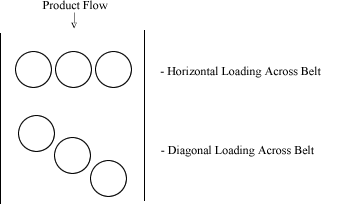 |
|
|
|
|
|
|
|
|
|
|
|
|
|
|
|
|
|
|
|
|
|
|
|
|
|
|
|
|
|
|
|
|
|
|
|
|
|
|
|
 |
Engineering Sizing |
||||||||||||||||||||||||||||||||||||||||||||||||||||||||||||||||||
Determine Belt LengthThe first thing needed for any spiral is to find how long the belt has to be. Use the questions below to help gather the information you will need.
Ok now it is time to use the information you have just collected above. Put the information into the formula below. Belt Length Formula:
Example:
Notes on This Example:
Determine Belt WidthBelt width selection is made by determining how the products will be loaded onto the spiral, what type of belt is being used and whether the spiral is an upgo or downgo. For downgo spirals add 2" to the belt width for hold down rail. Spiral Loading:
Belt Types:
Hold Down Rails: Hold down rails are commonly used on descending spirals and require and additional 2 inches of belt width. Belt Width Details This section gives you information on all widths and belt lengths per tier, outside frame dimensions, and will assist in the overall size of the spiral unit. Notes on Example: In this example, a 38" wide belt could easily be used if you chose a flex or plastic belt. A rod type belt would be more difficult, assuming a horizontal loading pattern. A 40" wide rod type belt could be a good choice. This example assumes and ascending spiral. Determining how many tiers are neededTiers are determined by taking active feet needed and dividing by feet per tier. Feet per tier can be seen on the attached charts showing all belt widths for a given radius. In this example, if we use a 38" wide belt with a standard 2.2 radius type belt, we see there is 63.88 ft per tier.
Determine belt radius to be used
If this is a straight through spiral, round out to 23 tiers Determine Tier PitchNeed highest/thickness product to be run in the spiral This number, is manufacturer specific, but the following guidelines will be accurate enough to determine what is needed for layouts and quotes: Highest Product to be run + 3.75" = tier pitch 3.75" allows for air movement above the product plus belt support structure and belt thickness. For critical sizing and space considerations, contact us for specific manufacturers support design dimensions. Taking our 12" pizza crust example, use 1" thickness for the product Based on this, we have a tier pitch requirement of at least 4.75". From a practical side of design, a more typical tier pitch would be 5.5" or 6", especially if you are using wider belts, which require a person’s arm to extend into the spiral for maintenance or clearing out products. Determine Discharge Heights/Overall Heights
Preliminary Information for you to use in Looking for a spiral:For this application, we need a spiral that has: 1450 ft of active belt With this information in hand, you can now go out and look for a spiral system knowing what you need. The next step is to get a price for this unit. Contact us for this, the closer you look the better we look |
||||||||||||||||||||||||||||||||||||||||||||||||||||||||||||||||||
|
|




